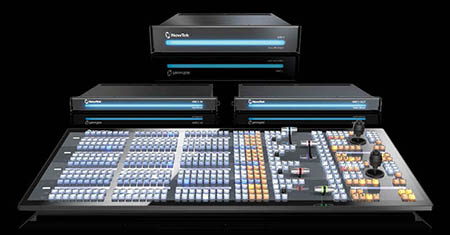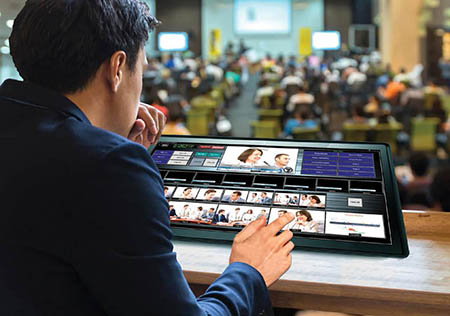Integrated Production Systems: Balancing Functionality With Flexibility
HAMILTON, N.J.—Integrated production systems are aptly named because they integrate the functionality of a production control room full of equipment within a single system. They’re designed so that one operator can control the entire video production—including tasks like multicamera switching, graphics, text, audio mixing, robotic camera control, playout and media streaming—from a single user interface.
While users don’t need to worry about the complexities of third party systems integration, they’re generally limited to whatever tools have been built into the box.
Nevertheless, with their ease of use and affordability, they’ve been widely adopted by the worship, corporate, education and government sectors, as well as for broadcast applications where space, personnel, skill and budgets are limited.

NewTek Tricaster
INTEGRATED STORYTELLING
One way to quickly give integrated production systems the ability to interface with external, third party gear is Network Device Interface (NDI). This bidirectional networking technology, spearheaded by NewTek, allows NDI-enabled third party devices residing on the same IP network to be used seamlessly together for production.
“NDI removes roadblocks to interoperability, especially for integrated production systems,” said Will Waters, director of product marketing for NewTek, in San Antonio. To date, hundreds of vendors have made their new and existing products, such as graphics and replay systems, NDI-capable. Products like NewTek Connect Pro—and Autolink for Panasonic PTZ (pan/tilt/zoom)—tie current cameras to NDI.
“The core software in our TriCaster integrated production system puts all the essential tools for creative video storytelling in one cost-effective system,” Waters said, “But customers may still want to interface their TriCasters with third party video systems, laptops or other external devices to further expand their production capabilities. NDI gives them the flexibility to do that using the one-gigabit network they may already have in place.”
The professional video industry's #1 source for news, trends and product and tech information. Sign up below.
Waters added that with TriCaster, and their IP Series IP-native switcher, NewTek customers could even deploy camera crews to shoot a show remotely in the field, but switch the video over IP in realtime back at the studio. “Provided that the customer has sufficient, dedicated bandwidth between the studio and field locations, the TriCaster can be used for remote NDI-based productions,” Waters said. “This allows more content to be created while reducing production costs.”
MAXIMIZING WORKFLOW
With its Ignite integrated production system, and GV Stratus Digital Media Platform (DMP), Grass Valley enables broadcasters to distribute content efficiently across their TV, web and mobile platforms.
“We overlay additional capabilities onto their existing newsroom production workflow to automate the repurposing, delivery and monetization of newscasts and other broadcast content for web and mobile platforms,” said Chuck Garfield, senior product manager at Grass Valley, in Portland, Ore. “This purpose-built, third-generation automation strengthens the broadcaster’s web and mobile presence without having to add to the personnel, workload or infrastructure.
“When delivering broadcast content to the web or mobile, our solution encapsulates closed captioning data into the online stream, which is legally required, as well as preserving rich metadata and channel branding,” Garfield added.
Server-side dynamic ad insertion (SSDAI) also lets broadcasters better monetize their VOD initiatives by dynamically swapping out old ads with new ones. For live streaming, it automates content replacement in instances where video footage is embargoed because the broadcaster doesn’t have the rights to use it on the web or on mobile. With its restful API and service oriented architecture, Grass Valley can quickly write new code for this integrated production solution to keep pace with changes in the fast-changing web, mobile, and OTT space.

Broadcast Pix Commander
TAKE CONTROL
Broadcast Pix’s Commander features an intuitive, automated touchscreen interface that makes it easier to control a multicamera video production, especially for nontechnical users. It can also be used as an option with other Broadcast Pix integrated production systems, such as the Flint and Granite series, which scale up to six and 22 multidefinition SDI inputs respectively.
“Our switchers are designed to make it easy to produce a broadcast-quality, multicamera video production,” said Tony Mastantuono, product manager for Broadcast Pix in Chelmsford, Mass. Using the touchscreen, an operator can select and broadcast a source—such as a camera, input feed, title, graphic, or clip—as well as zoom cameras, take a two-shot and other production tasks.
Mastantuono added that this ability to customize the user interface and control the production from an intuitive touchscreen makes their integrated production systems particularly attractive to public, education and government (PEG) channels, the worship, education and corporate markets, as well as small broadcast studios.
“Everything on our multiviewers can be resized or rearranged, and custom layouts can be saved for future use,” Mastantuono said. “Our user interface can also be made to simulate a production control room, with multiple control points so different tasks, like switching, graphics and audio, can be managed by multiple operators.” Broadcast Pix also offers an open API that lets users modify their system’s control structure to add an even greater level of custom control.
FUTURE PROOF
The vMix live production and streaming system is 4K and IP capable. It’s also NDI-capable, which enables networking with third-party devices, including those that support 4K and IP-based production.
According to Eric Pratt, CTO of U.S. Broadcast, in Northfield, N.H.—the U.S. distributor of the Australian based company—this system interfaces with native 4K/UHD cameras and provides 4K/UHD internal processing of integrated features like graphics, virtual sets, clip playback, streaming, recording and mixing. “Even if 4K content will not be broadcast in UHD, producing it in 4K means it will have superior image quality, and generate revenue for years to come,” Pratt said. “Opting for 4K/IP today also future-proofs the purchase.”
In addition to the vMix software that users load onto their computers, there are two turnkey versions: the vMix Go four- or eight-input SDI portable switcher, and vMix U 1RU 4-input switcher. And, since U.S. Broadcast also distributes PTZ Optics camera products, they offer a vMix Go PTZ bundle with integrated PTZ control via Ethernet.
ADVANCED CAMERA CONTROL
RUSHWORKS now offers LOCKED ON, an advanced robotic camera tracking system for use with its VDESK integrated production system. LOCKED ON leverages RFID (Radio Frequency Identification) tags and anchors that enable multiple pan/tilt/zoom robotic cameras—and RUSHWORKS’ PTX Universal PanTilt heads—to automatically follow one or more moving subjects within a production space.
“With its advanced algorithms and programming, this tracking system anticipates the way a director would call the shots and emulates how a good camera operator would follow the subject,” said Rush Beesley, president of RUSHWORKS, in Dallas.
During live production, the camera motion can follow rehearsed scenes or presets, or take shape on the fly. By locking onto signals from tiny RFID tags on a person or object, robotic PTZ cameras interpret positional data to track the subject’s movements, and even distinguish between different subjects while maintaining proper shot composition and focus.
“This solves one of our market’s biggest integrated production challenges by eliminating the need for one or more skilled camera operators, while enabling more dramatic, professional camera motion that elevates the production value of a show,” Beesley said. LOCKED ON will be demonstrated with VDESK at the 2017 NAB Show.
STUDIO TO GO
PortaCast integrated consoles from Mobile Studios include all the equipment producers need for remote production. According to President Rich Rubin in Deerfield Beach, Fla., “The consoles can be easily loaded and unloaded from a van using our telescoping aluminum PortaRamps, and set-up in minutes on location. This gives producers the option of producing their shows from inside or outside of the van.”
The PortaCast 50 is a suitcase-sized pelican case with a built-in Panasonic AW-HS50 five-input HD/SD switcher, 22-inch LED HD monitor, patch panel and optional PTZ camera controller, intercom, audio mixer and recording capabilities. Mobile Studios also designs customized travel cases for cameras, cables and accessories, which complement PortaCast flypacks.
PortaCast Classic Flypacks can include switchers from Panasonic, Ross, For-A, Sony and NewTek along with a 27-inch HD LCD monitor built into the flip-top lid. The PortaCast Deluxe, which is a production studio on wheels, features two 27-inch HD LED monitors installed in the hinged lid, a pullout drawer that serves as a switching control surface, a bench that doubles as storage for cables, and space for 22 rack units of components. PortaCast Deluxe has been used to produce complex live events for ESPN3 and Discovery Communications, in Miami, FL.
VIRTUALIZED SOLUTION
For Pixel Power, the essence of the company’s graphics systems—its software engine—can be embedded within third-party integrated production systems. This allows broadcasters to choose best-of-breed solutions that contain tools they need to preserve the distinctive channel branding they’ve already created using Pixel Power products.
In addition, the company’s roadmap includes the development of its own integrated production system, according to James Gilbert, CEO of the Grass Valley, Calif.-based company. “Broadcasters are already using our IP-based StreamMaster to perform complex master control playout tasks from the Amazon cloud, remote data centers and onpremise-based installations.”
With this virtualized software approach for master control, “they’re delivering live programming, without compromising production standards, such as live switching, channel branding, sophisticated 3D DVE, graphics and keying,” Gilbert said. “Based on that accomplishment, it’s not that big a leap to apply that underlying technology to a virtualized integrated production system for live applications.”

